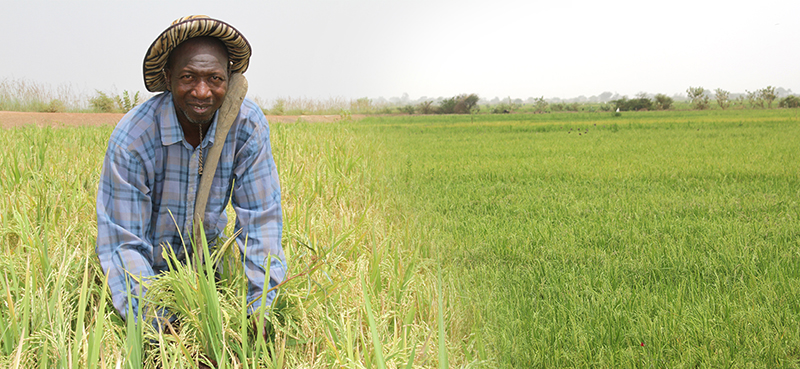
Mali 10 May 2018 /
Fifty-five-years old Boureima Sanogo has been cultivating rice since he was 15. With traditional cultivation methods on a hectare of land in the rainy season, the most yield he could get was four tons.
But since the introduction of a new cultivation method known as the System of Rice Intensification(SRI), an improved water management system, and drought-tolerant seed varieties, not only does he cultivate twice a year, but his yield also has doubled. Sanago now producers about 14 tons of rice every year.
This dad of 14 kids and two wives owns about two hectares of land in the rice fields located in San, about 450 kilometers East of Mali’s capital, Bamako. Before SRI, his maximum yearly income barely went above 500.000 FCFA (USD 1000).
But when you include off-season cultivation, he now makes close 2.5 million (USD 5000) from his 14 tons. One ton of rice now sells in Mali at about 175.000 FCFA (USD 350).
For a country where most people, particularly in rural households, live on about USD 2 per day, this is considerably above the country’s median income.
When we met him in the rice plains in San, Sanago looked relax and happy at this year’s off-season production.
“Next week, we shall begin harvesting. This will mark the end of the off-season. After that, we shall begin working on the cultivating for the regular season,” said Boureima Sanogo.

Experts say off-season cultivation starts from December through May while the regular season begins in June and end in October. Mali experiences some rainfall during the later period.
SRI Turns Drought to Irrigated Rice fields
Traveling through vast swaths of land in Mali in May can be particularly challenging because of the excruciating heat and high temperatures. With unpredictable rainfall, drought, and fluctuating weather patterns due in part to the changing climate, experts say, practicing agriculture can be extremely challenging. With degrading soils and inadequate farm inputs, the situation becomes even more desperate for small-scale farmers in particular.

But thanks to an agro-ecological, climate-smart and low-input methodology known as SRI, about 400 hectares of irrigated rice fields were cultivated between December 2017 and May 2018 in San, Mali,
“Climate change is a reality. But here in San, our rice fields are supplied by a water irrigation systems. This is what makes off-season rice cultivation possible,” says Sanago.
About 5000 farmers have constituted themselves into an association in San. They are called The Rice Farmers Association of the developed plains of the western San (APPASO). Thanks to their collective efforts, a channel irrigation system is allowing farmers access to water in their fields, helping them grow rice throughout the year and managing better worsening drought associated with climate change in Mali.
“Without this system, it will be impossible to stand the drought. Off-season rice cultivation is also impossible without a well-managed irrigation system,” says Ali Sanago, Technical adviser of APPASO.
“There are many advantages of SRI. Compared to our previous cultivation methods, fewer seeds are needed under SRI. Yields are higher under the SRI, and we use less water even in the off-season,” says another practitioner of SRI in San, Assie Togola

Scaling up SRI to Achieve Rice Self-Sufficiency in Mali
Experts have argued that if SRI is to make a real contribution to rice self-sufficiency in West Africa, many more farmers must adopt it.
“How many farmers must be reached before we reach the “tipping point” where SRI becomes the standard for rice cultivation in West Africa? A possible target for the follow-on project could be a farmer adoption rate of 33%, reaching 1.5 million rice farmers and 2.43 million hectares,” wrote Dr. Erika Styger and Dr. Gaoussou Traoré, authors of a recent publication on SRI in 13 West African countries,
“If 100% of rice farmers in West Africa had used SRI in 2017, rice self-sufficiency would already have been achieved with a 5% surplus. Replacing rice imports with rice grown in the region would have saved 4.16 billion USD in foreign exchange for 2017 alone,” they added.
Some Recommendations to Scale up SRI in West Africa
- . Expand national and regional coordination
- . Let farmers and farmer organizations take the lead
- . Refine and assure quality of technical training
- . Emphasize adaptation and innovation
- . Reinforce and improved the SRI monitoring systems
- . Expand the communication platform
Also read:
- . How Can West Africa Achieve Rice Self-Sufficiency? New Publication Offers Insights
- . SRI is Increasing Farmer’s Incomes in Mali
- . “West Africa Rice Must be Able to Compete with Imported Rice,” Dr. Abdoulaye Touré







